window Citroen C5 RHD 2014.5 (RD/TD) / 2.G Owner's Manual
[x] Cancel search | Manufacturer: CITROEN, Model Year: 2014.5, Model line: C5 RHD, Model: Citroen C5 RHD 2014.5 (RD/TD) / 2.GPages: 344, PDF Size: 12.9 MB
Page 4 of 344
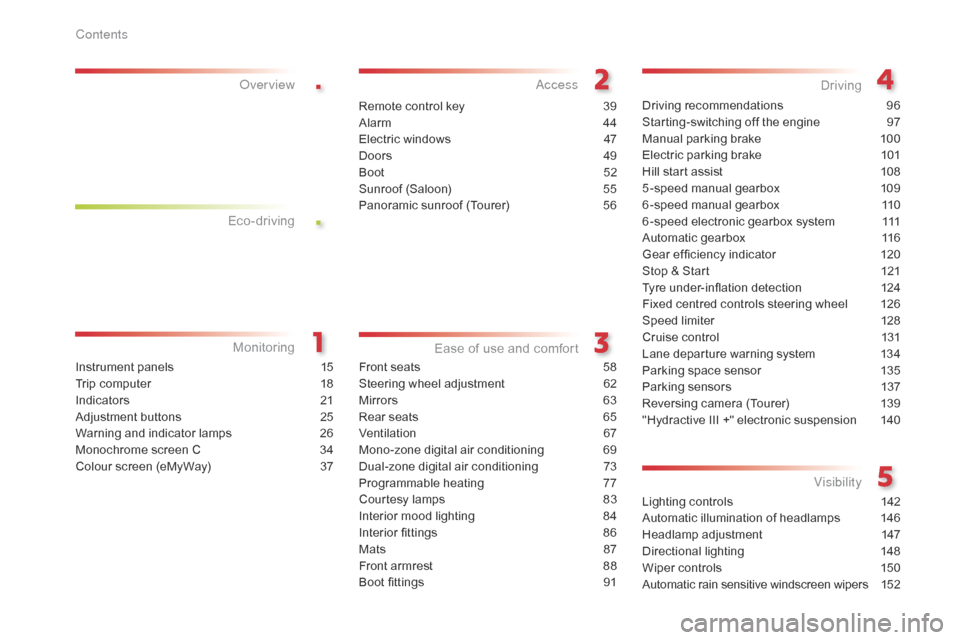
.
.
Instrument panels 15
Trip computer
1
8
Indicators
21
A
djustment buttons
2
5
Warning and indicator lamps
2
6
Monochrome screen C
3
4
Colour screen (eMyWay)
3
7
over view
Front seats 58
Steering wheel adjustment
6
2
Mirrors
6
3
Rear seats
6
5
Ventilation
6
7
Mono-zone digital air conditioning
6
9
Dual-zone digital air conditioning
7
3
Programmable heating
7
7
Courtesy lamps
8
3
Interior mood lighting
8
4
Interior fittings
8
6
Mats
87
F
ront armrest
8
8
Boot fittings
9
1Driving recommendations
9
6
Starting-switching off the engine
9
7
Manual parking brake
1
00
Electric parking brake
1
01
Hill start assist
1
08
5 -speed manual gearbox
1
09
6 -speed manual gearbox
1
10
6 -speed electronic gearbox system
1
11
Automatic gearbox
1
16
Gear ef ficiency indicator
1
20
Stop & Start
1
21
Tyre under-inflation detection
1
24
Fixed centred controls steering wheel
1
26
Speed limiter
1
28
Cruise control
1
31
Lane departure warning system 1 34
Parking space sensor 1 35
Parking sensors
1
37
Reversing camera (Tourer)
1
39
"Hydractive III +" electronic suspension
1
40
Lighting controls
1
42
Automatic illumination of headlamps
1
46
Headlamp adjustment
1
47
Directional lighting
1
48
Wiper controls
1
50
Automatic rain sensitive windscreen wipers
1
52
Eco-drivingMonitoring
a
ccess
Ease of use and comfort Driving
Visibility
Remote control key 3 9
Alarm
4
4
Electric windows
4
7
Doors
4
9
Boot
5
2
Sunroof (Saloon)
5
5
Panoramic sunroof (Tourer)
5
6
Contents
Page 6 of 344
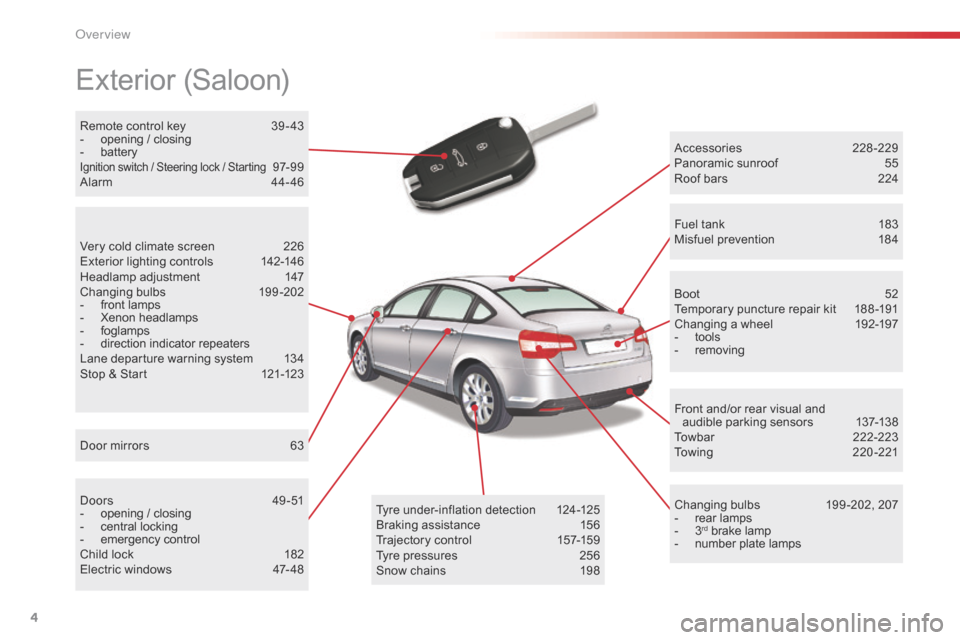
4
Exterior (Saloon)
Accessories 228-229
Panoramic sunroof 5 5
Roof bars
2
24
Changing bulbs
1
99 -202, 207
-
rear lamps
-
3rd brake lamp
-
number plate lamps
Boo
t
5
2
Temporary puncture repair kit
1
88 -191
Changing a wheel
1
92-197
-
tools
-
removing
T
yre under-inflation detection
1
24-125
Braking assistance
1
56
Trajectory control
1
57-159
Tyre pressures
2
56
Snow chains
1
98 Fuel tank
1
83
Misfuel prevention
1
84
Remote control key
3
9 - 43
-
opening / closing
-
batteryIgnition switch / Steering lock / Starting 97- 9 9
Alarm 4 4- 46
Door mirrors
6
3
Very cold climate screen
2
26
Exterior lighting controls
1
42-146
Headlamp adjustment
1
47
Changing bulbs
1
99-202
-
front lamps
-
Xenon headlamps
-
foglamps
-
direction indicator repeaters
L
ane departure warning system
1
34
Stop & Start
1
21-123
D o o r s
4
9 - 51
-
opening / closing
-
central locking
-
emergency control
C
hild lock
1
82
Electric windows
4
7- 48 Front and/or rear visual and
audible
parking sensors
1
37-138
Towbar
2
22-223
Towing
2
20-221
O
Page 8 of 344
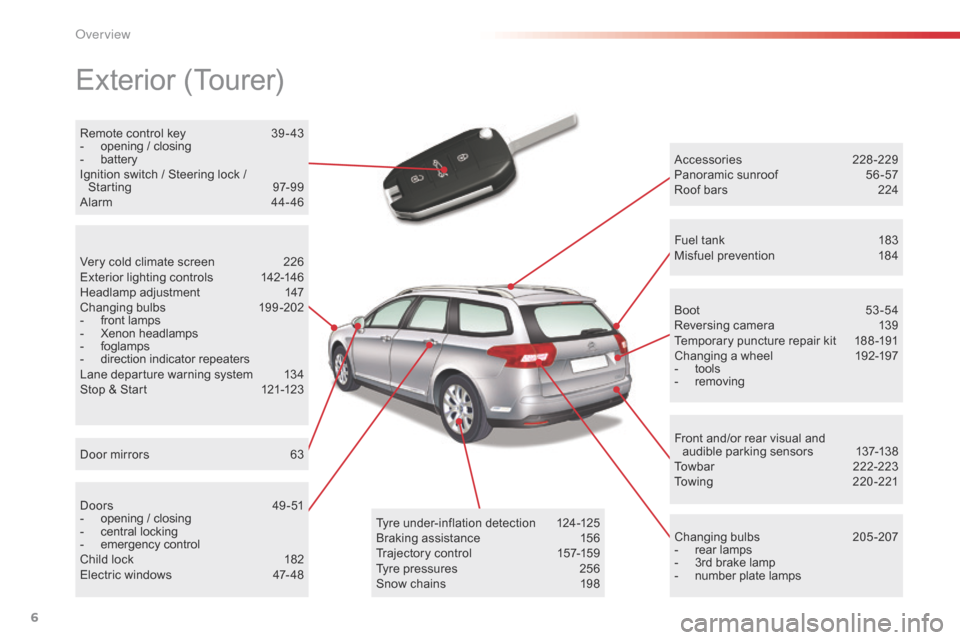
6
Exterior (Tourer)
Accessories 228-229
Panoramic sunroof 5 6 -57
Roof bars
2
24
Changing bulbs
2
05-207
-
rear lamps
-
3rd brake lamp
-
number plate lamps
Boo
t
5
3-54
Reversing camera
1
39
Temporary puncture repair kit
1
88 -191
Changing a wheel
1
92-197
-
tools
-
removing
T
yre under-inflation detection
1
24-125
Braking assistance
1
56
Trajectory control
1
57-159
Tyre pressures
2
56
Snow chains
1
98
Remote control key
3
9 - 43
-
opening / closing
-
battery
I
gnition switch / Steering lock / Starting
9
7-99
Alarm
4
4- 46 Fuel tank
1
83
Misfuel prevention
1
84
Door mirrors
6
3
Very cold climate screen
2
26
Exterior lighting controls
1
42-146
Headlamp adjustment
1
47
Changing bulbs
1
99-202
-
front lamps
-
Xenon headlamps
-
foglamps
-
direction indicator repeaters
L
ane departure warning system
1
34
Stop & Start
1
21-123
D o o r s
4
9 - 51
-
opening / closing
-
central locking
-
emergency control
C
hild lock
1
82
Electric windows
4
7- 48 Front and/or rear visual and
audible
parking sensors
1
37-138
Towbar
2
22-223
Towing
2
20-221
O
Page 9 of 344
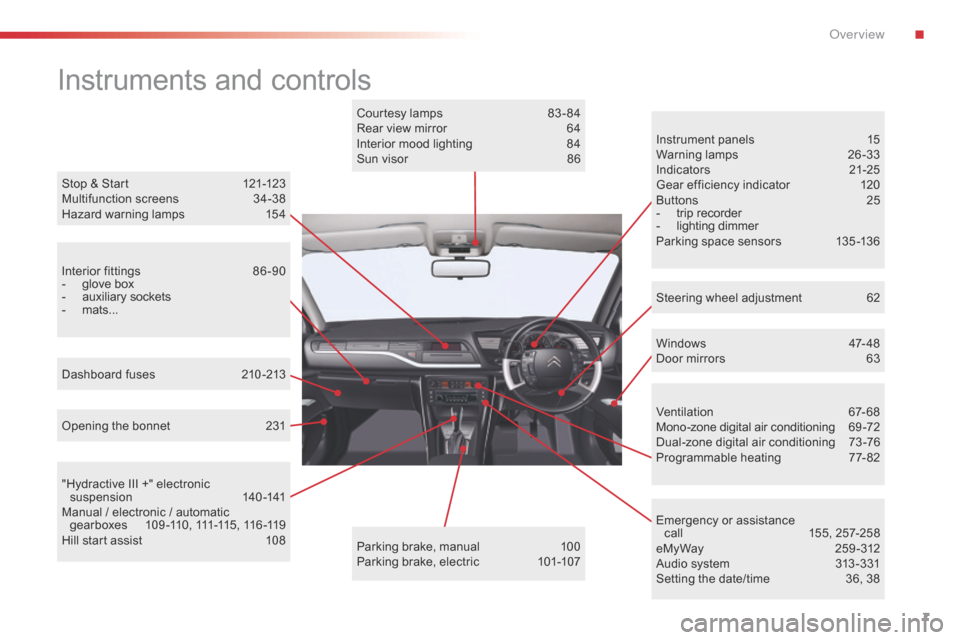
7
Instruments and controls
Instrument panels 15
Warning lamps 2 6-33
Indicators
2
1-25
Gear efficiency indicator
1
20
Buttons
2
5
-
trip recorder
-
lighting dimmer
P
arking space sensors
1
35 -136
Windows
4
7- 48
Door mirrors
6
3
Opening the bonnet
2
31
Dashboard fuses
2
10 -213
"Hydractive III +" electronic suspension
14
0 -141
Manual / electronic / automatic g e a r b o x e s
1
0 9 -11 0 , 111 -115 , 11 6 -11 9
Hill start assist
1
08 Courtesy lamps
8
3 - 84
Rear view mirror
6
4
Interior mood lighting
8
4
Sun visor
8
6
Parking brake, manual
1
00
Parking brake, electric
1
01-107
Stop & Start
1
21-123
Multifunction screens
3
4-38
Hazard warning lamps
1
54
Ventilation
6
7-68
Mono-zone digital air conditioning
6
9 -72
Dual-zone digital air conditioning
7
3-76
Programmable heating
7
7-82
Emergency or assistance call
1
55, 257-258
e My Way
2
59 - 312
Audio system
3
13 -331
Setting the date/time
3
6, 38
Steering wheel adjustment
6
2
Interior fittings
8
6 -90
-
glove box
-
auxiliary sockets
-
mats...
.
O
Page 15 of 344
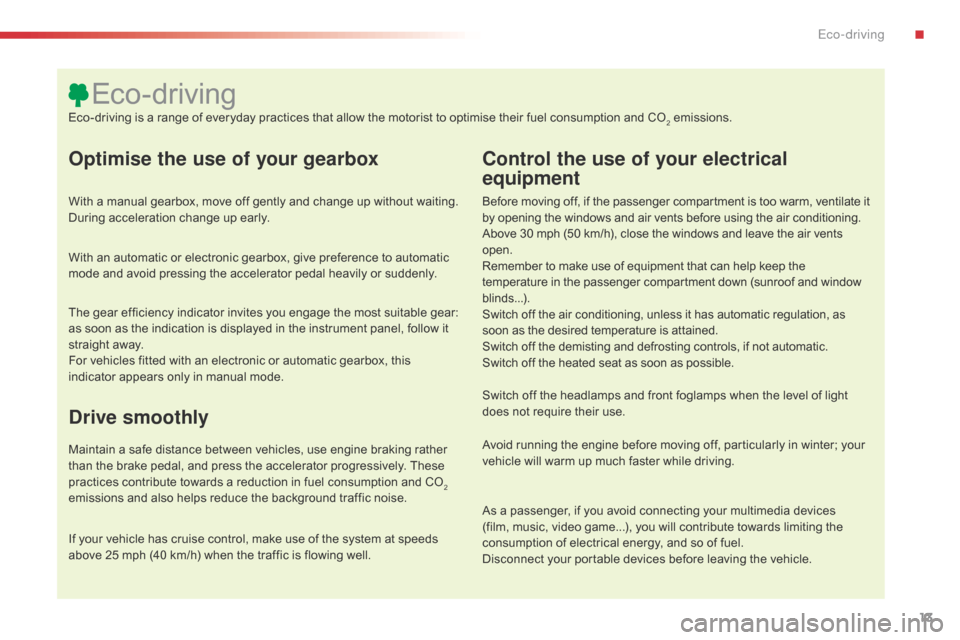
13
Optimise the use of your gearbox
With a manual gearbox, move off gently and change up without waiting.
During acceleration change up early.
With an automatic or electronic gearbox, give preference to automatic
mode and avoid pressing the accelerator pedal heavily or suddenly.
Control the use of your electrical
equipment
Before moving off, if the passenger compartment is too warm, ventilate it
by opening the windows and air vents before using the air conditioning.
Above 30 mph (50 km/h), close the windows and leave the air vents
open.
Remember to make use of equipment that can help keep the
temperature in the passenger compartment down (sunroof and window
blinds...).
Switch off the air conditioning, unless it has automatic regulation, as
soon as the desired temperature is attained.
Switch off the demisting and defrosting controls, if not automatic.
Switch off the heated seat as soon as possible.
Switch off the headlamps and front foglamps when the level of light
does not require their use.
Avoid running the engine before moving off, particularly in winter; your
vehicle will warm up much faster while driving.
As a passenger, if you avoid connecting your multimedia devices
(film, music, video game...), you will contribute towards limiting the
consumption of electrical energy, and so of fuel.
Disconnect your portable devices before leaving the vehicle.
Eco-driving
Eco-driving is a range of everyday practices that allow the motorist to optimise their fuel consumption and CO2 emissions.
The gear efficiency indicator invites you engage the most suitable gear:
as soon as the indication is displayed in the instrument panel, follow it
straight away.
For vehicles fitted with an electronic or automatic gearbox, this
indicator appears only in manual mode.
Drive smoothly
Maintain a safe distance between vehicles, use engine braking rather
than the brake pedal, and press the accelerator progressively. These
practices contribute towards a reduction in fuel consumption and CO
2
emissions and also helps reduce the background traffic noise.
If your vehicle has cruise control, make use of the system at speeds
above 25 mph (40 km/h) when the traffic is flowing well.
.
Eco-driving
Page 42 of 344
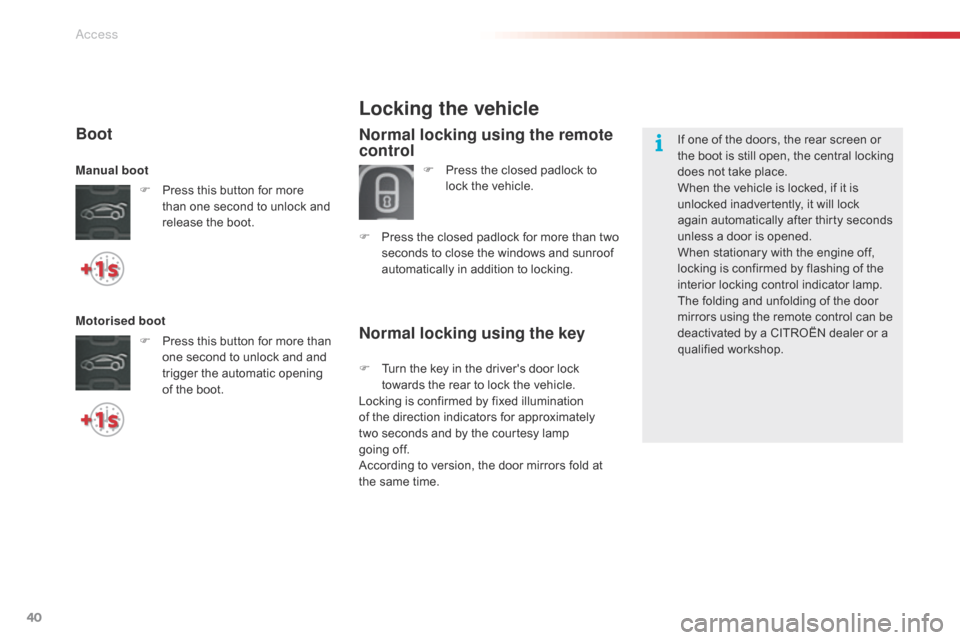
40
Normal locking using the key
Locking the vehicle
Normal locking using the remote
control
F Press the closed padlock to lock the vehicle.
F
P
ress the closed padlock for more than two
seconds to close the windows and sunroof
automatically in addition to locking. If one of the doors, the rear screen or
the boot is still open, the central locking
does not take place.
When the vehicle is locked, if it is
unlocked inadvertently, it will lock
again automatically after thirty seconds
unless a door is opened.
When stationary with the engine off,
locking is confirmed by flashing of the
interior locking control indicator lamp.
The folding and unfolding of the door
mirrors using the remote control can be
deactivated by a CITROËN dealer or a
qualified workshop.
F
T
urn the key in the driver's door lock
towards the rear to lock the vehicle.
Locking is confirmed by fixed illumination
of the direction indicators for approximately
two
seconds and by the courtesy lamp
going
off.
According to version, the door mirrors fold at
the same time.
Boot
F Press this button for more than one second to unlock and
release the boot.
Manual
boot
Motorised boot
F
P
ress this button for more than
one second to unlock and and
trigger the automatic opening
of the boot.
Access
Page 43 of 344
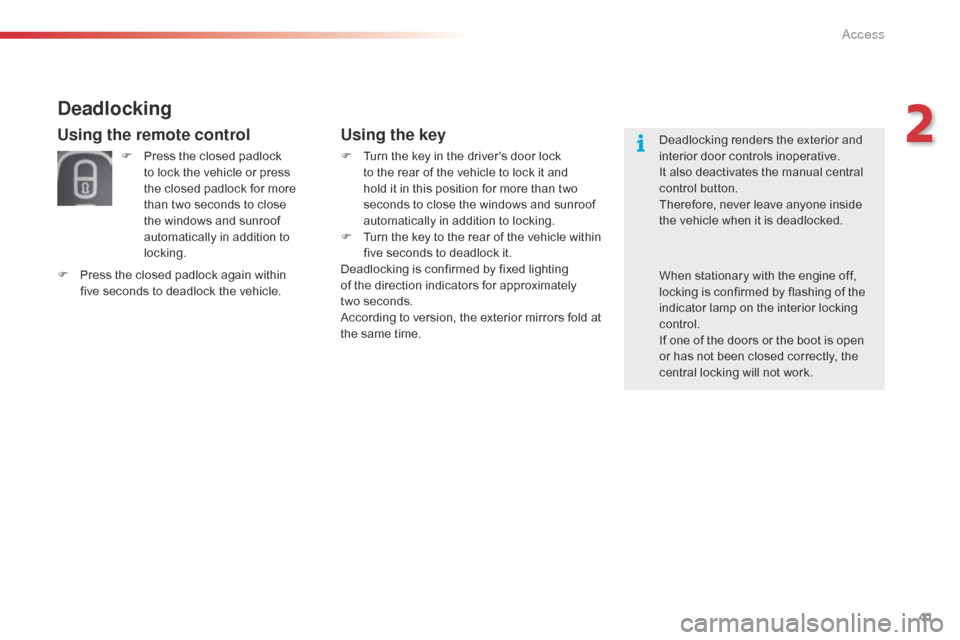
41
F Turn the key in the driver's door lock to the rear of the vehicle to lock it and
hold it in this position for more than two
seconds to close the windows and sunroof
automatically in addition to locking.
F
T
urn the key to the rear of the vehicle within
five seconds to deadlock it.
Deadlocking is confirmed by fixed lighting
of the direction indicators for approximately
two
seconds.
According to version, the exterior mirrors fold at
the same time.
Using the key
When stationary with the engine off,
locking is confirmed by flashing of the
indicator lamp on the interior locking
control.
If one of the doors or the boot is open
or has not been closed correctly, the
central locking will not work. Deadlocking renders the exterior and
interior door controls inoperative.
It also deactivates the manual central
control button.
Therefore, never leave anyone inside
the vehicle when it is deadlocked.
Deadlocking
F Press the closed padlock to lock the vehicle or press
the closed padlock for more
than two seconds to close
the windows and sunroof
automatically in addition to
locking.
F
P
ress the closed padlock again within
five
seconds to deadlock the vehicle.
Using the remote control
2
Access
Page 46 of 344
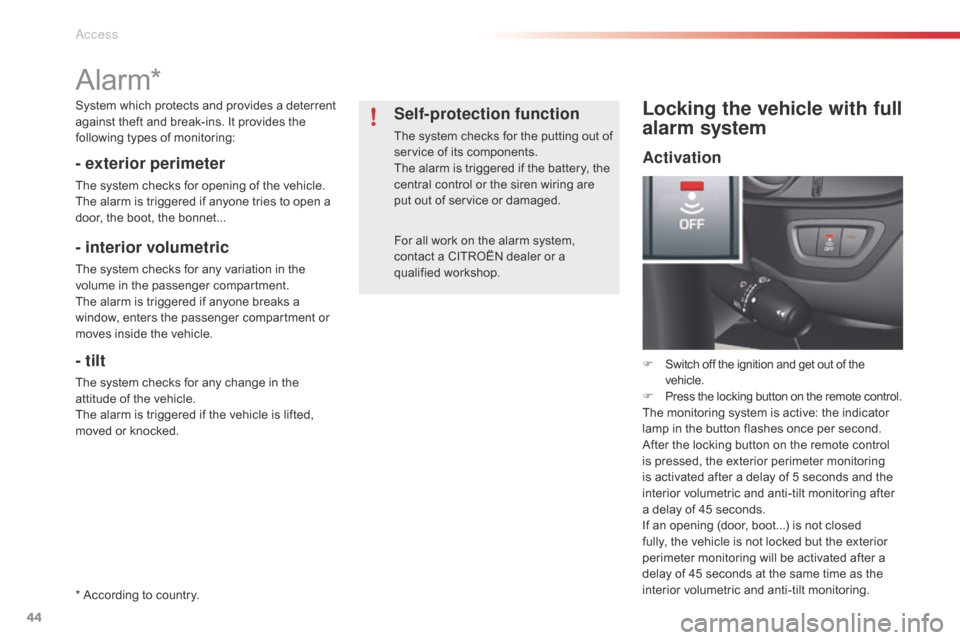
44
Alarm*
- exterior perimeter
The system checks for opening of the vehicle.
The alarm is triggered if anyone tries to open a
door, the boot, the bonnet...
- interior volumetric
The system checks for any variation in the
volume in the passenger compartment.
The alarm is triggered if anyone breaks a
window, enters the passenger compartment or
moves inside the vehicle.
- tilt
The system checks for any change in the
attitude of the vehicle.
The alarm is triggered if the vehicle is lifted,
moved or knocked.
Locking the vehicle with full
alarm system
Activation
* According to country.
Self-protection function
The system checks for the putting out of
service of its components.
The alarm is triggered if the battery, the
central control or the siren wiring are
put out of service or damaged.
For all work on the alarm system,
contact a CITROËN dealer or a
qualified workshop.
System which protects and provides a deterrent
against theft and break-ins. It provides the
following types of monitoring:
F
Switch off the ignition and get out of the
vehicle.
F Press the locking button on the remote control.The monitoring system is active: the indicator
lamp in the button flashes once per second.
After the locking button on the remote control
is pressed, the exterior perimeter monitoring
is activated after a delay of 5 seconds and the
interior volumetric and anti-tilt monitoring after
a delay of 45 seconds.
If an opening (door, boot...) is not closed
fully, the vehicle is not locked but the exterior
perimeter monitoring will be activated after a
delay of 45 seconds at the same time as the
interior volumetric and anti-tilt monitoring.
Access
Page 47 of 344

45
Deactivation
F Press the unlocking button on the remote control.
The alarm system is deactivated: the indicator
lamp in the button goes off.
Locking the vehicle
with exterior perimeter
monitoring only
Deactivate the interior volumetric and anti-tilt
monitoring to avoid unwanted triggering of the
alarm in certain cases such as:
-
l
eaving a pet in the vehicle,
-
l
eaving a window partially open,
-
w
ashing your vehicle,
-
c
hanging a wheel,
-
h
aving your vehicle towed,
-
t
ransport by sea.
Deactivation of the interior
volumetric and anti-tilt
monitoring
F Switch off the ignition.
F W ithin ten seconds, press the button until
the indicator lamp is on continuously.
F
G
et out of the vehicle.
F
P
ress the locking button on the remote
control immediately.
The exterior perimeter monitoring alone is
activated: the indicator lamp in the button
flashes once per second.
To be effective, this deactivation must be carried
out each time the ignition is switched off.
Reactivation of the interior
volumetric and anti-tilt monitoring
F Press the unlocking button on the remote control to deactivate the exterior perimeter
monitoring.
F
P
ress the locking button on the remote
control to activate all the monitoring
functions.
The indicator lamp in the button again flashes
once per second.
2
Access
Page 49 of 344

47
Electric windows
1. Driver's electric window control.
2. Passenger's electric window control.
3.
R
ear right electric window control.
4.
R
ear left electric window control.
5.
D
eactivation of the rear electric window
and door controls.
One-touch electric windows
- automatic mode F P ress or pull the control firmly. The
window opens or closes fully when the
control is released.
F
P
ressing the control again stops the
movement of the window.
Safety anti-pinch
When the window rises and meets an obstacle,
it stops and partially lowers again.
The electric window controls remain
operational for approximately
45
seconds after the ignition is switched
off or until the vehicle is locked after a
door is opened.
If one of the passenger windows cannot
be operated from the driver's door
control panel, carry out the operation
from the control panel of the passenger
door concerned, and vice versa. If the window cannot be closed (for
example, in the presence of ice),
immediately after the movement is
reversed:
F
p
ress and hold the control until the
window opens fully,
F
t
hen pull the control immediately
and hold it until the window closes,
F
c
ontinue to hold the control for
approximately one second after the
window has closed.
The safety anti-pinch function is not
operational during these operations.
There are two options:
-
m
anual mode
F
P
ress or pull the control gently. The
window stops when the control is
released.
2
Access